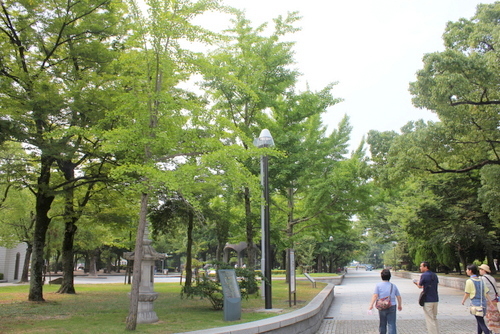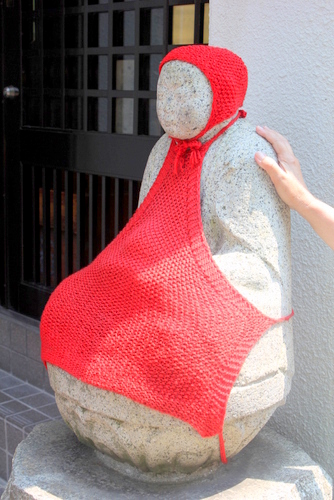We had actually booked a full day Hiroshima sightseeing tour from Australia before we came over, but when we were reading through the documentation on the Shinkansen the previous day, we realised that the tour included a trip over to the nearby Miyajima Island. Our itinerary already had us going to Miyajima after our stay in Hiroshima, with an overnight there. Miyajima as a tiny island, so since we really didn't want to go there twice, we cancelled our tour, and set off to explore on our own.
We crossed over the river from the A-Bomb dome and wandered through the Peace Park.
One of the most conspicuous monuments in the park is the Childrens Monument, around which there are little booths full of paper cranes.
I think the girl at the top is Sadako Sasaki, the girl who became ill from the radiation after the bombing and tried to fold a thousand origami paper cranes, because according to Japanese legend, if someone makes a thousand cranes that entitles them to make a wish, and she wished to live.
And now thousands and thousands of paper cranes are brought to the monument.
Some arranged more spectacularly than the others!
We moved on from the Childrens Monument pas the Peace Flame, which was being cleaned at the time (but still burning, as you can see). You can also see some tents and a crane in the background of this shot.
This was because we were visiting only a few days before the anniversary of the bombing on 6th August. They were making preparations for the big event. We were extremely impressed by these meticulously taped out lines on the ground, which we assume were for chairs.
We made our way from there to the Peace Memorial Museum, where we were very grateful to be in air conditioning. We discovered there that we could go on a free walking tour of the museum and the Peace Park with a volunteer English-speaking guide. That sounded much better to us than paying a fortune for the tour we'd booked that doubled up on our itinerary!
We were a little early, so had a look around the foyer. This is the Peace Watch, which marks both the number of days since the bombing of Hiroshima, and also the number of days since the last nuclear test, worldwide. On that day, it had been 257 days since the last test. I think the concept of all the little cogs is that the more testing that goes on over time, the higher cogs will eventually make the cogs lower down start to move, and the bottom one is embedded in concrete, so if it moves the whole thing will implode. Something along those lines. It's supposed to signify that nuclear energy will destroy humanity eventually.
Our tour started, and we made our way inside the museum. The first section was organised as a bit of a timeline of Japan's political moves in the years leading up to the bombing. They were an ambitious little nation, to say the least! Our guide, who was a local, although she spoke English quite well, had a very strong accent, and spoke very softly. So to catch what she was saying, we had to stand very very close to her, and concentrate like our lives depended on it! It was hard work, but I managed to keep it up long enough to get the gist of what happened.
Because of the language barrier and the fact that we didn't spend enough time with our guide going through the history for me to confidently explain any of it, I'll move straight on to the next section, which focused on the atomic bombing itself and then its aftermath.
This is a watch that stopped at the moment of impact, at 8:15, and has been preserved.
They had a big scale model of what this area of Hiroshima looked like before the bombing...
And a model of what it looked like afterward. As you can see, nearly all buildings were destroyed, because they were made up almost entirely of timber, and simply burned to the ground.
They had a replica of the A-bomb Dome building's dome which was pretty spectacular.
This is me doing a bad job of capturing a photo of what happens on the anniversary of the bombing each year. Lanterns are released onto the river. Very beautiful.
These are aerial maps of Hiroshima before and after the bombing. Our guide is the one in the green shirt. She was a lovely lady.
Up on the higher level of the museum we had an opportunity to look out over the tents being prepared, and you can see the little squiggly concrete thing just above them which is the Memorial Cenotaph.
Further into the museum, they had a series of photographs that were taken after the blast occurred. This one was pretty incredible. The photo itself was probably about 2 metres tall, and you can see the outlines of little people in the bottom left corner, which shows how enormous the mushroom cloud was.
This is Tom with a replica of the bomb itself. Its size surprised me! So little!
This is a tricycle and helmet that belonged to a little boy who was out riding it when the blast occurred. He and the bike were badly burned, and he died shortly afteward. His father, thinking the little boy was too young to be buried in a lonely grave, buried him in their backyard along with the tricycle and helmet, thinking he could play with them. The boy's remains were later moved to the family grave, and the bicycle and helmet donated to the Peace Memorial Museum.
This is an artists impression of the fire that took over the city after the blast.
Here's Tom holding a piece of rubble.
And here are some of Sasako's paper cranes! They were absolutely tiny, and apparently because there was a shortage of paper, they were made out of little medicine wrappers.
It was only once we were on the higher level of the museum that we realised the clever way that the Peace Park was designed. The museum looks straight onto the Memorial Cenotaph, which looks straight onto the Peace Flame, which looks straight across the park, over the river, to the A-bomb Dome. Quite impressive.
We then braved the heat again and our guide took us outside. I managed to take this shot under the Memorial Cenotaph of the Peace Flame and A-bomb Dome. Apparently this was the first time that our guide had ever seen people working on the Peace Flame (you can see them in white suits), so although we were sad that they spoiled the view a bit, at least we felt like we'd seen something rare!
Our guide then took us to the Childrens Monument, where we got to admire the paper cranes up close...
So beautiful!
And then we moved on to see some of the other aspects of the park. There was a temple located where the Peace Park now is, before the bombing. This is apparently a gravestone that was torn apart by the blast.
Our guide showed us a picture of what they normally look like. You can see how the ball sections were thrown off.
We then moved along to the Peace Bell...
And Tom had a go at ringing it...
We saw the Memorial Tower to the Mobilized Students, which was erected by bereaved families whose children (students) were required to perform labour service in munitions factories as a result of the Student Labour Service Act in 1944. In Hiroshima, of the students who were affected by this Act, 75% died in the bombing. This recognises all of them.
We passed the A-bomb dome again... such a spectacular building.
And then took a trip a couple of streets away to the temple that used to be located on the site of the Peace Park but was rebuilt a little distance away after the bombing.
We could just spot the graveyard through the carpark.
A few more streets away was what is apparently the epicentre of the blast, where the bomb itself actually dropped. There is now this plaque (which our lovely guide is standing next to) and a hospital located there.
We visited a few more little areas as we went back towards the museum, although this was certainly the only one we could safely call "entertaining"! What a spectacularly well-packed bike!
At the end of the tour, we asked our guide where we should go to get Okonomiyaki for lunch, a Hiroshima specialty. We were expecting her to point us in a direction and give us a few instructions, but instead, she took us at a high-speed walk straight to a restaurant, blocks and blocks away! We were amazed! And before we could even thank her properly, she disappeared!
So, we settled in to enjoy our lunch.
It was...interesting. I can't say that the seafood on mine really improved it much. I think the plain version is probably preferable. We of course got a tourist menu (in English), so our choices were probably a little more limited (and expensive) than those offered to locals.
Apparently the only way to eat Okonomiyaki is to absolutely cover it in sauce and mayonnaise. As you can see, Tom had no problem with that.
So that was our very full (and serious) morning in Hiroshima! We needed all the Okonomiyaki fuel we could get to give us energy for what we had planned for the afternoon!











































No comments:
Post a Comment